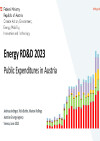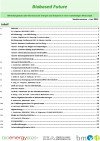Suchergebnisse für "Factsheet: Energietechnologien gestalten, die für alle sinnvoll und nutzbar sind"
Kongress: Kluge Strategien im Passivhausbau
10. Jun 2003 -
11. Jun 2003
A-3922 Großschönau, SchönauerhofGroßschönau, AT
FVV Großschönau veranstaltet diesen Fachkongress im Vorfeld der 18. BIOEM
Energy R&D 2023: Public Expenditures in Austria

Public spending on energy research totalled 310.8 million euros in 2023. The figure for 2021, by far the highest ever recorded in Austria, was therefore exceeded.
Schriftenreihe
16/2024
A. Indinger, F. Bettin, M. Rollings
Herausgeber: BMK
Deutsch, 150 Seiten
Downloads zur Publikation
IEA DHC Annex TS3: Hybrid Energy Networks, District Heating and Cooling Networks in an Integrated Energy System Context Guidebook
Hybrid energy networks, i.e. the integration of electricity, heat and gas networks, can make a decisive contribution to optimizing the energy system. The IEA DHC Annex TS3 analyses the potentials and challenges of hybrid energy networks from the perspective of the district heating / cooling system. This is including the analyses of relevant technologies and synergies, an assessment of the different methodological approaches and tools, the analyses of case studies as well as the development of suitable business models and regulations.
Pathways to sustainable construction. Experiences and prospective European research strategies

The aim of this study is to investigate the international research context of the programme "Building of Tomorrow" (with a focus on central, eastern and southern European countries) and to identify co-operation potentials.
Development of a Window for Passive-Housing Featuring an Integrated Sun Shield

Development of a laminated wooden/aluminum window for a passive-housing featuring an integrated sun shield in the shape of blinds or of folding net curtain.
IEA AFC Annex 31: Polymer electrolyte membrane fuel cell (Working period 2017 - 2019)
Task 31 is a research and development oriented Task with the objective to contribute to the identification and development of techniques and materials to reduce the cost and improve the durability of polymer electrolyte fuel cells (PEFCs).
Workshop: CFD aided design and other design tools for industrial biomass combustion plants
6. June 2013
Bella Center, room 19
Copenhagen, DK
IEA Bioenergy Task 32 organises an expert workshop on Computational Fluid Dynamics (CFD) aided design as a side event of the EU Biomass Conference to share practical experiences and address the current opportunities and limitations of CFD based design of industrial biomass combustion appliances
Manage_GeoCity - Development of a method for the coordinated management of geothermal energy in urban areas
Based on the urban region Graz a method had been developed for the coordinated use and management of shallow geothermal energy for heating and cooling as well as seasonal heat storage in urban regions. Ground water flow, different geologic conditions, heating and cooling demand, heat input from solar collectors and industrial waste heat and the possibilities of seasonal heat storage in the subsurface were considered.
e-genius.at: The Open Content knowledge and learning platform
The objective of the project was to develop online teaching materials on the topics energy-efficient buildings and renewable energy sources in collaboration with technical vocational schools and vocational higher secondary schools.
Renovation with passive house technology by master-builder – verified planning documentation – Guide and seminars
The project aims at an increased implementation of passive house technology by the planning as well as the operating master-builder.
Booklet issued by Building of Tomorrow with about 20 practical passive house thermal bridges free connection details for large-volume residential buildings
In particular, for buildings with very low energy consumption on heating the influence of heat bridges have a special value. Since in passive house construction a largely heat bridge free execution is required, the most frequent and significant heat bridges are collected in a booklet.
Mitteilungsblatt "Biobased Future" - Sondernummer/Juni 2012

HR DI M. Wörgetter, DI D. Bacovsky, DI (FH) A. Sonnleitner
Herausgeber: Bioenergy2020+ GmbH, Mitherausgeber für den Sonderteil IEA Bioenergy: JOANNEUM RESEARCH Forschungsgesellschaft - DI Kurt Könighofer
Deutsch, 32 Seiten
Downloads zur Publikation
Management of the loads of public water treatment plants - ARAFIT
ARAFIT develops a concept for the regional management of the loads of public water treatment plants in a partnership of planners, operators and major water consumers following the idea of sustainable least cost planning resulting in efficient, flexible and future oriented regional infrastructure.
ECR Energy City Graz - subproject 3: +ERS - Plus Energy Network Reininghaus Süd
The multifunctional neighbourhood "+ERS - Plus Energy Network Reininghaus Süd" was realized within the urban planning area of Graz-Reininghaus. The project aims to optimize the energy concept of the single buildings as well as of the building cluster in order to achieve a plus-energy standard within the residential neighbourhood.
Quality criteria for the Building of Tomorrow
Development and implementation of contributions to the quality control of innovative technologies in the areas of building services and insulation that are derived substantially from HAUSderZukunft findings.
GrünStattGrau – Innovations for Greening Cities "The green living laboratory"
GrünStadtGrau represents the holistic of competence for green building technologies such as green roofs and living walls in Austria. It generates impulses for urban green infrastructure on buildings and links innovative products and projects, supports through know-how and analysis for implementation processes. GrünStattGrau guides urban and participatory strategies from development to implementation.
IEA-PVPS Task 13: Performance, Operation and Reliability of Photovoltaic Systems (Working period 2018 - 2021)
The IEA Task 13 develops independent, internationally valid analyses and recommendations for the operation and reliability of PV systems and their components. The continuation of the Austrian participation ensures the flow of information back to the Austrian photovoltaic industry through international cooperation and strengthens Austria as a location for innovation and production.
IEA PVPS Task 15: Acceleration of BIPV
Building integrated Photovoltaics (BIPV) is one of the future markets for Photovoltaics which enables the combination of architecture and energy technology. The project focussed on further national research in the area of BIPV, which is to be raised to an international level.
ERSCP 2021 - European Roundtable on Sustainable Consumption and Production
8. - 10. September 2021
Graz
ERSCP21 will consider the possibilities to reduce the emission of climate-relevant gases during production as well as to reduce upstream emissions by changing consumer behavior. The topics discussed at the conference cover a number of UN Sustainable Development Goals.
IEA AFC Annex 35: High‐Purity Hydrogen Production with the Reformer Steam Iron Cycle (2018)

Demonstration eines Laborprototyps zur dezentralen Herstellung von hochreinem Wasserstoff aus Biogas.
S. Nestl, G. Voitic, R. Zacharias, S. Bock, V. Hacker
Herausgeber: Wiley-VCH, Energy Technology
Englisch, 7 Seiten
